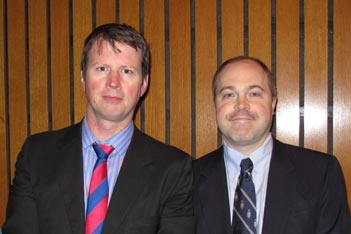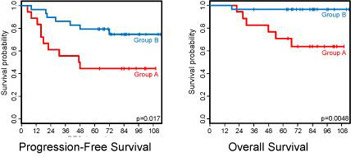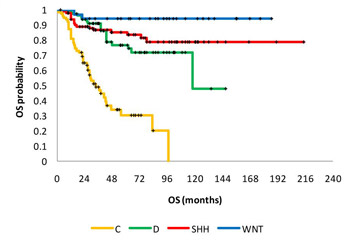Reducing Toxicity of Tumor Treatment

Tom Waddell and Michael Taylor with a November moustache for Cancer Research
Michael Taylor won the George Armstrong Peters Prize
for 2011. His studies advance our understanding of
cancer through genetic analysis of cancer transcriptomes.
These are genetic markers derived from the genome of
particular cancers that will allow prognostication at a
level that has not been achieved using operative findings
of the extent of disease, clinical or pathological staging
or microscopic analysis.
In his Peters Prize Lecture at Surgical Grand Rounds,
Michael described the microarray analysis of over 400
ependymomas of gene products, collected in Heidelberg
and Toronto. Immunohistochemical analysis of gene
products identified two classes of ependymomas that are
otherwise indistinguishable. Tumours in group A had a
far worse prognosis (Figure 1). Those in group B have a
far better prognosis and tend to be easier to resect. They
less frequently wrap around cranial nerves in the posterior
fosae or invade vessels to the brain stem. It may be
that eventually we will be able to spare the young developing
residual brain from the debililating effects of postoperative
radiation in patients with group B tumors.

Fig. 1. Ependymoma Survival Curves
|
Medulloblastoma, the second major category of pediatric
brain tumors, sort into four completely different groups,
despite their histologic similarity. The sorting can be
accomplished similarly with immunohistochemistry
based on their genetic makeup (Figure 2). These genetic
characteristics also show distinct differences between
primary and metastatic tumours from the same patient
or between primary and recurrent tumours. We are not
yet at a point where the immunohistochemistry of the
transcriptome can be used to guide surgery in the operating
room, but the information can be used to determine
whether adjuvant therapy is appropriate. Those with the
WNT mutation have sufficiently favorable prognosis
that a randomized trial will soon be undertaken in which
the innovative arm will be the omission of postoperative
radiation. This multi-centre program of de-escalation of
toxic treatment will be financed by a grant from CIHR
and support from the Garon Family Pediatric Cancer
Centre at the Hospital for Sick Children. The Children’s
Oncology Group in the United States is exploring retrospective
validation of the prognostic groups based
on their immunohistochemistry. This will allow future
therapeutic trials using these genetic markers to stratify
treatment.

Michael’s wife of 16 years, Susan, is a technical writer
who edits his grants with a detectable level of impact
on his excellent record of funding. His children are
Alexandra, 12, Robert 9 and Andrew, 5. On the night
before his Peters Prize presentation he was up working
with Robert on a challenging math homework assignment.
He is currently reading Michael Shermer’s “The
Believing Brain”. His principal mentors have been Jim
Rutka and Richard Gilbertson at the St. Jude Hospital
in Memphis, Tennessee.
M.M.
|